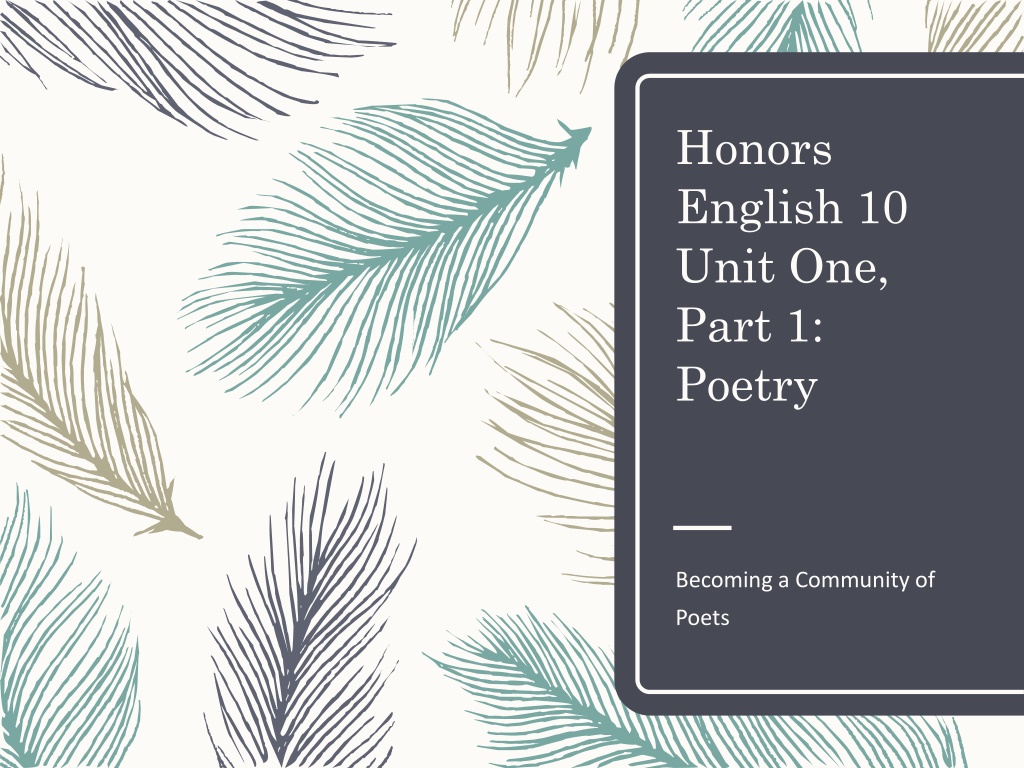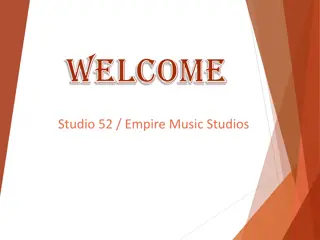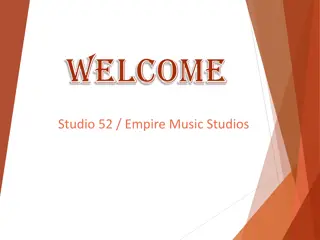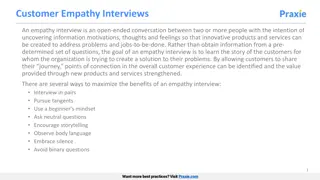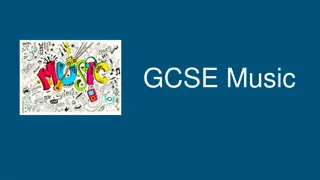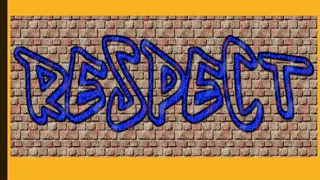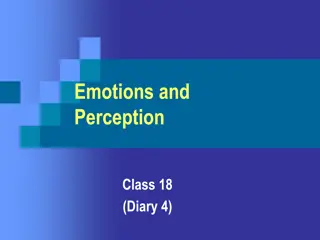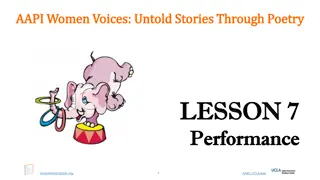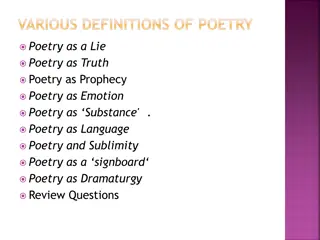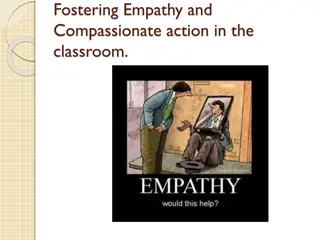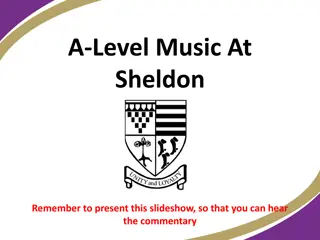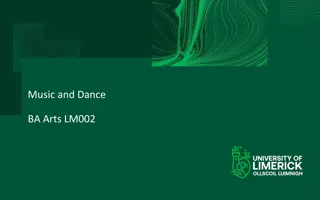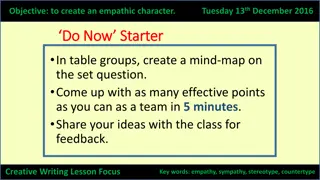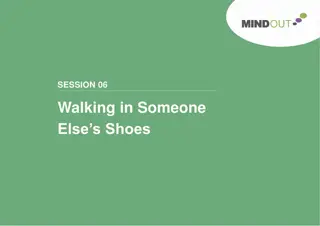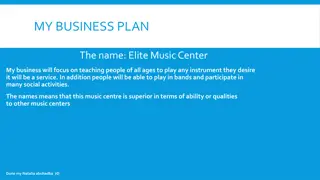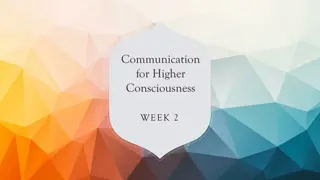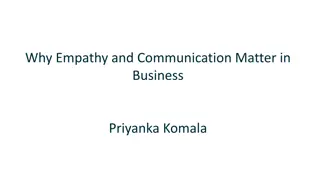Explore the World of Poetry through Music and Empathy
Delve into the realm of poetry through the harmonious blend of music and empathy in the Honors English 10 Unit One, Part 1: Poetry Becoming a Community of Poets. Uncover the profound connection between lyrics and poetic expressions while discovering the power of empathy and support in the poetic journey. Engage with the poetic musings of Ms. Cronk's favorite song, "Atlas" by Coldplay, and embark on a creative exploration by selecting a song that resonates with your essence for a unique poetry assignment. Unleash your poetic potential with insights from young contemporary writers and embrace the transformative evolution of a writer.
Download Presentation

Please find below an Image/Link to download the presentation.
The content on the website is provided AS IS for your information and personal use only. It may not be sold, licensed, or shared on other websites without obtaining consent from the author. Download presentation by click this link. If you encounter any issues during the download, it is possible that the publisher has removed the file from their server.
E N D
Presentation Transcript
Honors English 10 Unit One, Part 1: Poetry Becoming a Community of Poets
Session One Poetry is the music of the soul, and, above all, of great and feeling souls. -Voltaire
Music as Poetry How many of you can recite the lyrics of your favorite songs or at least sing along? How many of you regularly look up and read the lyrics of songs you hear? You are already reading poetry!
Ms. Cronks Favorite Song: Atlas by Coldplay Some saw the sun Some saw the smoke Some heard the gun Some bent the bow Some far away Some search for gold Some dragon to slay Heaven we hope Is just up the road Show me the way, Lord 'Cause I am about to explode Sometimes the wire Must tense for the note Caught in the fire, say oh We're about to explode Carry your world I'll carry your world Carry your world I'll carry your world Carry your world (Carry your world) And all your hurt Carry your world I'll carry your world Carry your world I'll carry your world Carry your world Carry your world
So.why does Ms. Cronk feel so connected to Atlas ? Fantasy references Euphony (pleasing sounds) Reference to variety of responses to difficulty and challenge Sense of responsibility to respond to challenges (the world) Choice of response: I ll carry your world .and all your hurt Empathy/support of others in pain
Session One Short-term Homework Choose a favorite song that you feel represents who you are and/or the way you look at the world. Write your full name and the title and artist of your chosen song on your puzzle piece. Decorate the front of your puzzle piece in a way that connects to you and/or the song (make sure we can still read the words!) This can be as simple or detailed as you like. Bring your puzzle piece and the PRINTED lyrics to your song to the next class.
Think you cant write poetry? You can! Take some advice from young contemporary writers: invitation by Mackenzie Connellee Evolution of a Writer by Lauren Stacks
Session Two Three grey geese in a green field grazing, Grey were the geese and green was the grazing. Mother Goose
Group Share In your table group, take turns sharing your chosen song from the homework, reading the lyrics aloud. You may explain as much or as little as you like about why you feel connected to the song and why it represents you and/or your world view. Turn in your puzzle piece to Ms. Cronk.
Common Poetic Techniques Used in Music Repetition Refrains Rhyme/Rhyme scheme Meter/Rhythm Simile and/or metaphor (figures of speech) Consonance Assonance Alliteration Can you find examples of each of these in Atlas ?
Examining Atlas by Coldplay More Closely Some saw the sun Some saw the smoke Some heard the gun Some bent the bow Some far away Some search for gold Some dragon to slay Heaven we hope Is just up the road Show me the way, Lord 'Cause I am about to explode Sometimes the wire Must tense for the note Caught in the fire, say oh We're about to explode Carry your world I'll carry your world Carry your world I'll carry your world Carry your world (Carry your world) And all your hurt Carry your world I'll carry your world Carry your world I'll carry your world Carry your world Carry your world
Alliteration Alliteration is a literary device that repeats a speech sound in a sequence of words that are close to each other. Alliteration typically uses consonants at the beginning of a word to give stress to its syllable. Alliteration plays a very crucial role in poetry and literature. Alliteration provides a work with musical rhythms. Poems that use alliteration are read and recited with more interest and appeal. Poems with alliteration can be easier to memorize. Alliteration lends structure, flow, and beauty to any piece of writing.
Consonance Consonance is a pleasing sounding caused by the repetition of consonant sounds within sentences, phrases, or in poems. Typically this repetition occurs at the end of the words, but may also be found within a word or at the beginning. Consonance is related to alliteration, and is used for much the same purposes. Consonance can influence, or be part of, rhyming sounds.
Assonance Assonance is the repetition of vowel sounds in nearby words. It can occur at the beginning, end, or middle of words. Assonance is often used to reinforce the meaning of words or to set the mood. Assonance is inherently involved in the creation of rhyming sounds, often in collaboration with consonance.
Where can we find alliteration, consonance, and assonance? Tongue twisters and nursery rhymes: Peter Piper picked a peck of pickled peppers. A peck of pickled peppers Peter Piper picked. If Peter Piper picked a peck of pickled peppers, how many pickled peppers did Peter Piper pick? How much wood would a woodchuck chuck If a woodchuck would chuck wood? A woodchuck would chuck all the wood he could chuck If a woodchuck would chuck wood. Little Miss Muffet sat on a tuffet, eating her curds and whey. Along came a spider who sat down beside her, and frightened Miss Muffet away.
Alliteration, consonance, and assonance in children s books Through three cheese trees three free fleas flew. While these fleas flew, freezy breeze blew. Freezy breeze made these three trees freeze. Freezy trees made these trees cheese freeze. That s what made these three free fleas sneeze. -- Fox in Socks by Dr. Seuss I'll swing by my ankles. She'll cling to your knees. As you hang by your nose, From a high-up trapeze. But just one thing, please, As we float through the breeze, Don't sneeze. -- Acrobats by Shel Silverstein
Alliteration, consonance, and assonance in poetry Do not go gentle into that good night, T was later when the summer went Than when the cricket came, And yet we knew that gentle clock Meant nought but going home. T was sooner when the cricket went Than when the winter came, Yet that pathetic pendulum Keeps esoteric time. Old age should burn and rave at close of day; Rage, rage, against the dying of the light. . . . Grave men, near death, who see with blinding sight Blind eyes could blaze like meteors and be gay, Rage, rage against the dying of the light. -- Do Not Go Gentle Into That Good Night by Dylan Thomas -- T was later when the summer went by Emily Dickinson
Alliteration, consonance, and assonance in a single line And the silken sad uncertain rustling of each purple curtain --from The Raven by Edgar Allan Poe
Finding alliteration, consonance, and assonance Read Birches by Robert Frost and use a highlighter and pen to mark examples of alliteration, consonance, and assonance. Note how their use influences the way you read and interpret the poem. Be prepared to discuss as a class.
Try it on your own Try writing a few lines or even a short poem that use alliteration, consonance, assonance, or even a combination of all three. It can be as silly or serious as you like. Be prepared to share with a partner. If you re stuck, try thinking of a single letter sound (consonant or vowel) and write a series of words that use the same sound. Then see if you can fit some of those words together with bridging words in order to make a coherent sentence/poem.
Partner Work Share your writing with your partner. Partners, see if you can identify the use of alliteration, consonance, and/or assonance in your partner s work. Give feedback on what works and what could be improved.
Session Two Homework We often associate the use of alliteration, consonance, and assonance with children s poetry, although it is also used very effectively in adult s poetry. When starting out in using these techniques, it may be helpful to approach them from a child s perspective. Think of an emotional event in your childhood (fun, happy, sad, confusing, etc.) and write about the event using alliteration, consonance, and assonance to relate the story. Break it up into lines in order to create a poem. You may find yourself rhyming that s fine! Just don t force it too much. Write a poem of at least ten lines this way.
Session Three To the swinging and the ringing of the bells, bells, bells- Of the bells, bells, bells, bells Bells, bells, bells- To the rhyming and the chiming of the bells! Edgar Allan Poe
Repetition Repetition is used to emphasize a feeling or idea, create rhythm, and/or develop a sense of urgency. Repetition is repeating words, phrases, lines, or stanzas. [Stanzas are lines that are grouped together in separation from other stanzas or lines.] We hear repetition all around us: commercials repeat sales and slogans to intensify what they're saying and to burn them into our brains. Song lyrics often repeat lines and have catchy choruses that we can easily sing along to and remember.
Repetition in poetry I Think I ll Call It Morning by Gil Scott-Heron One Art by Elizabeth Bishop The Rhythm of the Tomtom by Ant nio Jacinto
Independent Practice Choose a phrase of at least three words (or a full sentence) you would like to use repeatedly in a poem. Write a poem of at least fifteen lines in which that phrase appears repeatedly (though it doesn t have to be in every line.) Ideas if you re stuck: I remember when I should be There was a time You told me Now I realize
Rhyme Rhyme is a repetition of similar sounding words, occurring at the end of lines in poems or songs. A rhyme is a tool utilizing repeating patterns that bring rhythm or musicality to poems. A rhyme is employed for the specific purpose of rendering a pleasing effect to a poem, which makes its recital an enjoyable experience. Moreover, it offers itself as a mnemonic device, smoothing the progress of memorization.
Rhyme in poetry Stopping by Woods on a Snowy Evening by Robert Frost His and Hers by Diane Gilliam Fisher Recess by Maria Hummel
Independent Practice Try your hand at a rhyming poem. Choose a simple rhyme scheme and work with simple rhyming words, to begin. Write a poem of at least eight lines.
Free Verse Free verse has no set rhyme or meter; that is to say there is no rhyming scheme present, and the poem doesn t follow a set pattern. For some poets writing in free verse serves as a handy tool for the purpose of camouflaging their fluctuation of thoughts, whereas others think that it positively affects the quality of work being presented, since the poet is not forced into rhyme and/or pattern.
Free verse in poetry (most contemporary poetry) Clearly Through My Tears by Susan Love Fitts Kindness by Naomi Shihab Nye Photons by Nicole Guenther
Independent Practice Try your hand at a free verse poem. Don t let yourself be controlled by rhyme, meter, or pattern. Just let your thoughts flow, using line and stanza breaks to add meaning and a certain amount of rhythm to your words. Write a poem of at least ten lines this way.
Session Three Homework Take a look at the three poems you worked on today. Work with them further to either finish or extend them. Pick the one style you prefer between rhyming and free verse poetry. Write an additional poem in that style, also using some sort of repetition, of at least fifteen lines.
Session Four Metaphors have a way of holding the most truth in the least space. Orson Scott Card
Metaphors and Similes Metaphors are direct comparisons between two things that state one thing is another, in order help explain an idea or show hidden similarities. Because poems are meant to impart complex images and feelings to a reader, metaphors often state comparisons poignantly. Similes have a similar concept to metaphors they also are comparisons between two things but they use the words like or as for the comparison, rather than being direct.
Metaphors in poetry I m a riddle in nine syllables, An elephant, a ponderous house, A melon strolling on two tendrils. O red fruit, ivory, fine timbers! This loaf s big with its yeasty rising. Money s new-minted in this fat purse. I m a means, a stage, a cow in calf. I ve eaten a bag of green apples, Boarded the train there s no getting off. -- Metaphors by Sylvia Plath
More metaphors Hope is the thing with feathers -- That perches in the soul -- And sings the tune without the words -- And never stops -- at all -- I ve heard it in the chillest land -- And on the strangest Sea -- Yet -- never -- in Extremity, It asked a crumb -- of me. And sweetest -- in the Gale -- is heard -- And sore must be the storm -- That could abash the little Bird That kept so many warm -- -- Hope is the Thing With Feathers by Emily Dickinson
Similes in poetry What did we say to each other that now we are as the deer who walk in single file with heads high with ears forward with eyes watchful with hooves always placed on firm ground in whose limbs there is latent flight -- Simile by N. Scott Momaday
More similes Poised between going on and back, pulled Both ways taut like a tightrope-walker, Fingertips pointing the opposites, Now bouncing tiptoe like a dropped ball Or a kid skipping rope, come on, come on, Running a scattering of steps sidewise, How he teeters, skitters, tingles, teases, Taunts them, hovers like an ecstatic bird, He's only flirting, crowd him, crowd him, Delicate, delicate, delicate, delicate now! -- The Base Stealer by Robert Francis
Independent Practice Practice creating metaphors and similes by creating five metaphors and five similes out of the following concepts. Consider: what comparison could you make to bring the concept to life for your reader? * The sun * Writing * A book * Your bed * A baby * A cat * A [sport] game * [Your favorite food] * A sports car * A tree
Share Volunteers share their favorite metaphor or simile from the exercise. Discuss as a class what makes a metaphor or simile successful.
Session Four Homework Write a poem of at least ten lines that explores the concept of your choice using metaphors and/or similes. Try to extend at least one metaphor or simile beyond a single line, elaborating on the comparison. You may use one of the metaphors or similes you created in the exercise, or you may make up (a) new one(s), as you prefer.
Session Five Images are the heart of poetry You re not a poet without imagery. Anne Sexton
Imagery Imagery is descriptive language that has the ability of appealing to the five senses. However, that does not necessarily mean that imagery applies to all five senses collectively. There are seven types of imagery: visual, auditory, olfactory, gustatory, tactile, kinesthetic and organic
Types of imagery: the five senses Visual imagery appeals to the sense of sight, and plays the largest role in imagery in literature. It describes what a scene or character looks like. Olfactory imagery describes a particular scent. Gustatory imagery describes the way something tastes. Auditory imagery describes specific sounds that are happening within the story. Tactile imagery describes the way something feels to the touch.
Types of imagery: beyond the senses alone Kinesthetic imagery is a type of visual imagery that specifically deals with the movement or actions of something or someone. Organic imagery is the most difficult form of imagery to write, because it deals with creating a specific feeling or emotion within the reader. Phrases that make the reader feel sad, fearful, nostalgic, elated, even lost are all extremely effective organic imagery.
Imagery in poetry Preludes by T. S. Eliot Fourth or fifth love by Mary Selph Sunflower by Rolf Jacobsen
Independent Practice Choose at least one type of imagery and write a descriptive paragraph about a strong memory you have. Think carefully about how you are appealing to the senses, or (if using one of the last two types) going beyond the senses with your descriptive language. Feel free to incorporate metaphors and similes, but go beyond the simple comparisons to fully describe the moment. Now transform your descriptive paragraph into a poem. You can do this simply by adding appropriate line breaks, or you can transform the prose further into poetic language.
Personification Personification is a type of metaphor and a common literary tool. It is when the writer assigns the qualities of a person to something that isn't human or that isn't even alive, like nature or emotions. can be used as a method of describing something so that others can more easily understand it. can be used to emphasize a point. can be used to help paint a picture in your mind.
What personification is NOT Personification is NOT anthropomorphism, which means making an object or animal act and look like they are human, as in many children s books. Personification is a type of imagery/descriptive language, instead of a transformation.
